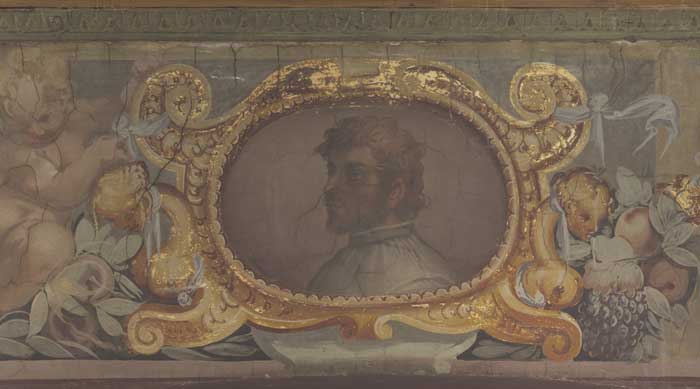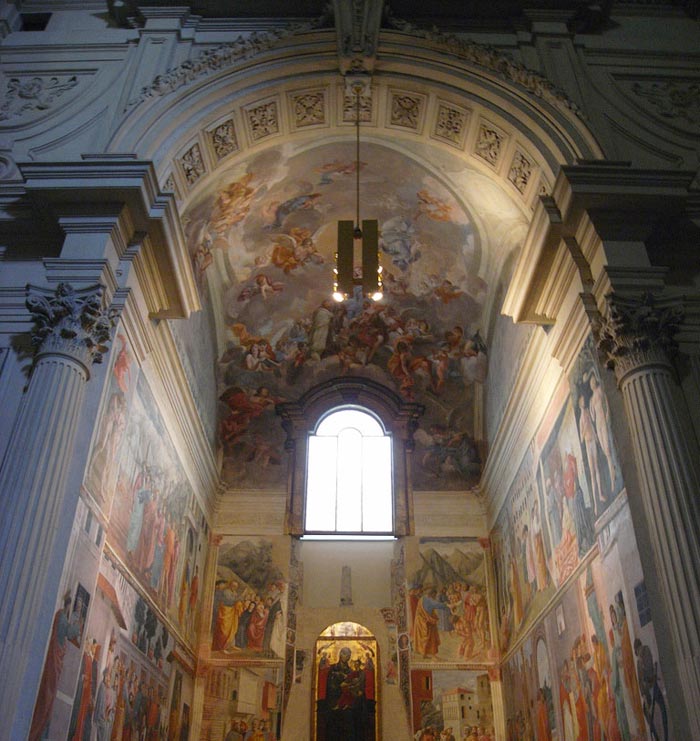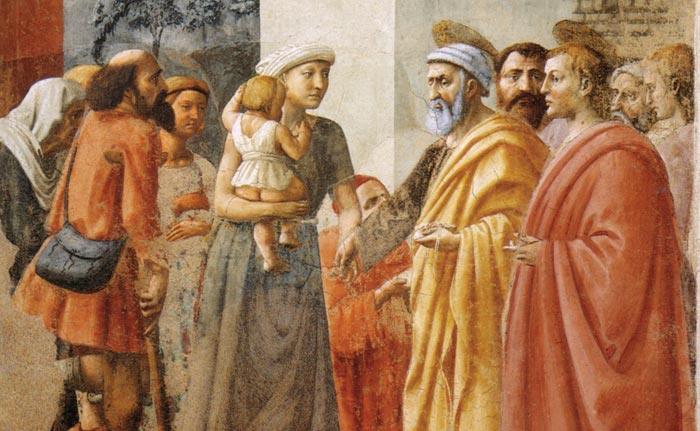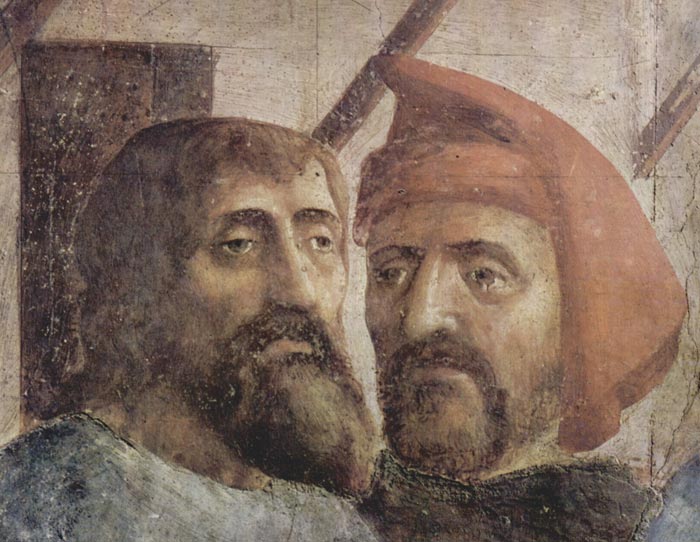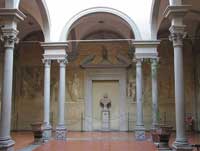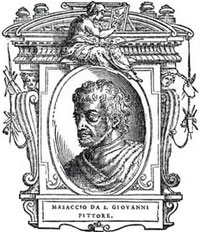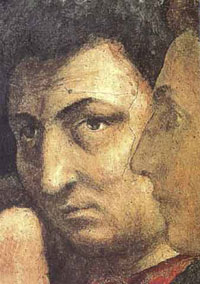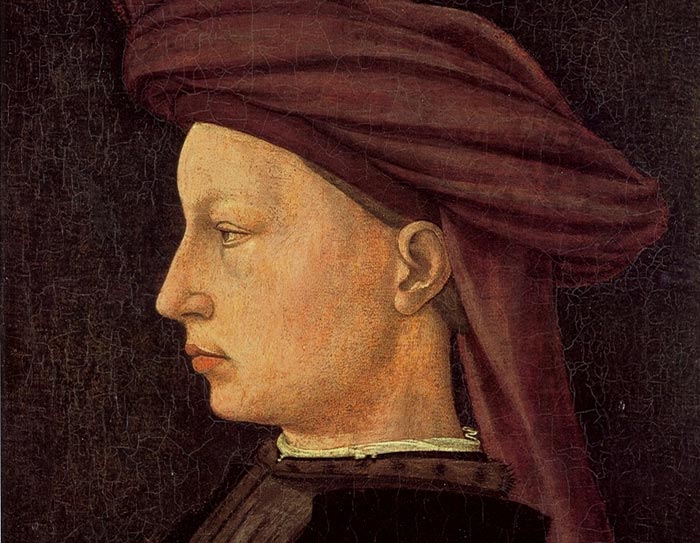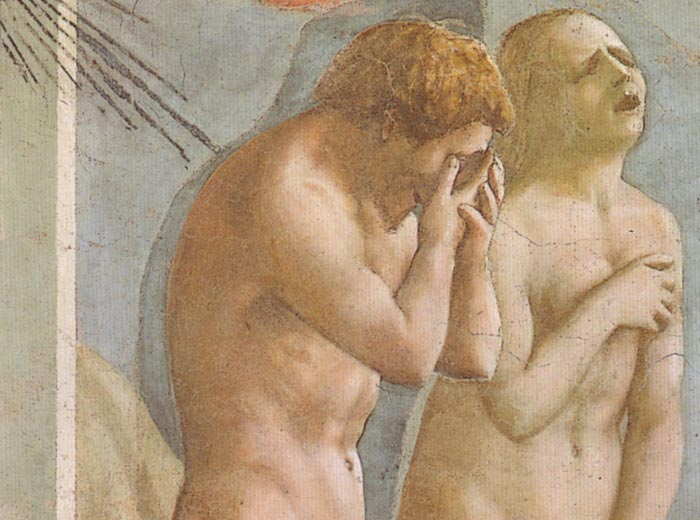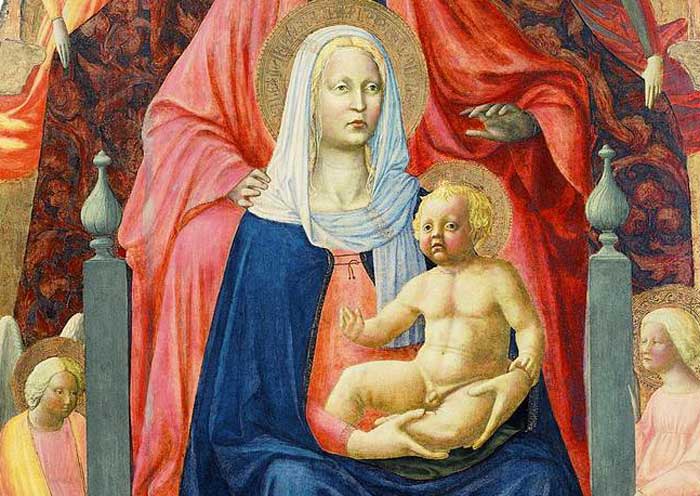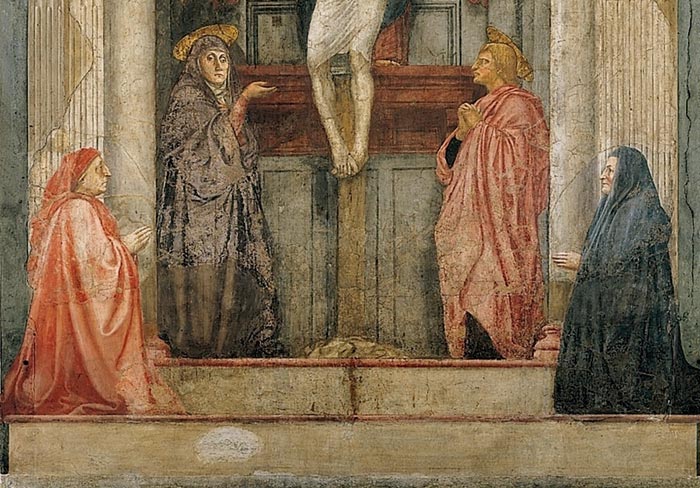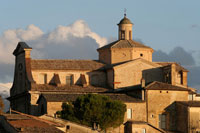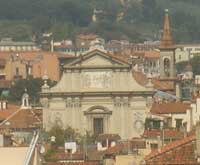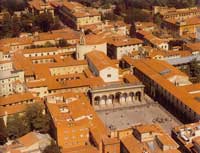He began painting at the time when Masolino da Panicale was working on the Chapel of the Brancacci in the Carmine, in Florence, ever following, in so far as he was able, in the steps of Filippo and Donato, although their branch of art was different, and seeking continually in his work to make his figures very lifelike and with a beautiful liveliness in the likeness of nature. And his lineaments and his painting were so modern and so different from those of the others, that his works can safely stand in comparison with any drawing and coloring of our own day. He was very zealous at his labours, and a marvellous master of the difficulties of perspective, as it is seen in a story painted by him with small figures, which is today in the house of Ridolfo del Ghirlandajo. In this story, besides a Christ who is delivering the man possessed by a devil, there are very beautiful buildings in perspective, drawn in a manner that they show at one and the same time both the inside and the outside, by reason of his having chosen the point of view, not of the front, but over the corners, as being more difficult. He sought more than any other master to make his figures nude and foreshortened, which was little done before his day. He had great facility in handling, and, as it has been said, he is very simple in his draperies.
There is a panel by his hand, wrought in distemper, wherein is a Madonna upon the lap of S. Anne, with the Child in her arms. This panel is today in S. Ambrogio in Florence, in the chapel that is beside the door that leads to the parlour of the nuns. And in the tramezzo of the Church of S. Niccolo, on the other side of the Arno, there is a panel by the hand of Masaccio, painted in distemper, wherein, besides the Madonna, who is receiving the Annunciation from the Angel, there is a building with many columns, drawn in perspective and very beautiful, seeing that, besides the drawing of the lines, which is perfect, he made it recede by means of the colouring, in a manner that little by little, almost imperceptibly, it is lost to view; thus showing clearly his knowledge of perspective. In the Badia of Florence, on a pilaster opposite to one of those that support the arch of the high altar, he painted in fresco S. Ivo of Brittany, representing him within a niche, in order that the feet might appear foreshortened to the eye below ; which device, not having been used so well by others, acquired for him no small praise. And below the said Saint, over another cornice, he made a throng of widows, orphans, and beggars, who receive assistance from that Saint in their needs. In S. Maria Novella, also, below the tramezzo of the church, he painted a Trinity in fresco, which is placed over the altar of S. Ignazio, with Our Lady on one side and S. John the Evangelist on the other contemplating Christ Crucified. On the sides are two figures on their knees, which, in so far as it can be determined, are portraits of the men who had the picture painted; but little is seen of them, for they have been covered with a gilt ornament. But the most beautiful thing, apart from the figures, is a barrel-shaped vaulting, drawn in perspective and divided into squares filled with rosettes, which are foreshortened and made to diminish so well that the wall appears to be pierced. In S. Maria Maggiore, also, near the side-door that leads to S. Giovanni, on the panel of a chapel, he painted a Madonna, with S. Catherine and S. Julian. On the predella he made some little figures, connected with the life of S. Catherine, with S. Julian murdering his father and mother; and in the middle he made the Nativity of Christ, with that simplicity and vividness which were characteristic of his work.
In the Church of the Carmine in Pisa, on a panel that is in a chapel in the tramezzo, f there is a Madonna with the Child, by his hand, and at her feet are certain little angels sounding instruments, one of whom, playing on a lute, is listening attentively to the harmony of that sound. On either side of the Madonna are S. Peter, S. John the Baptist, S. Julian, and S. Nicholas, all very lifelike and vivacious figures. In the predella below are scenes from the lives of those Saints, with little figures; and in the centre are the three Magi offering their treasures to Christ. In this part are some horses portrayed from life, so beautiful that nothing better can be desired; and the men of the Court of those three Kings are clothed in various costumes that were worn in those times. And above, as an ornament for the said panel, there are, in several squares, many saints round a Crucifix. It is believed that the figure of a saint, in the robes of a Bishop and painted in fresco, which is in that church, beside the door that leads into the convent, is by the hand of Masaccio; but I hold it as certain that it is by the hand of Fra Filippo, his disciple.
Returning from Pisa to Florence, he wrought there a panel containing a man and a woman, nude and of the size of life, which is today in the Palla Rucellai Palace. Then, not feeling at ease in Florence, and stimulated by his affection and love for art, he determined to go to Rome, in order to learn and to surpass others; and this he did. And having acquired very great fame there, he painted for Cardinal San Clemente a chapel in the Church of S. Clemente, wherein he made in fresco the Passion of Christ, with the Thieves on the Cross, and the stories of S. Catherine the martyr. He also made many panels in distemper, which have been all lost or destroyed in the troublous times of Rome ; one being in the Church of S. Maria Maggiore, in a little chapel near the sacristy, wherein are four saints, so well wrought that they appear to be in relief, and in the midst of them is S. Maria della Neve, with the portrait from nature of Pope Martin, who is tracing out the foundations of that church with a hoe, and beside him the Emperor Sigismund II. Michelagnolo and I were one day examining this work, when he praised it much, and then added that these men were alive in Masaccio's time. To him, while Pisanello and Gentile da Fabriano were laboring in Rome for Pope Martin on the walls of the Church of S. Gianni, these masters had allotted a part of the work, when he returned to Florence, having had news that Cosimo de' Medici, by whom he was much assisted and favored, had been recalled from exile; and there he was commissioned to paint the Chapel of the Brancacci in the Carmine, by reason of the death of Masolino da Panicale, who had begun it; but before putting his hand to this, he made, by way of specimen, the S. Paul that is near the bell ropes, in order to show the improvement that he had made in his art. And he demonstrated truly infinite excellence in this picture, for in the head of that Saint, who is Bartolo di Angiolino Angiolini portrayed from life, there is seen an expression so awful that there appears to be nothing lacking in that figure save speech; and he who has not known S. Paul will see, by looking at this picture, his honorable Roman culture, together with the unconquerable strength of that most divine spirit, all intent on the work of the faith. In this same picture, likewise, he showed a power of foreshortening things viewed from below upwards which was truly marvellous, as may still be seen to-day in the feet of the said Apostle, for this was a difficulty that he solved completely, in contrast with the old rude manner, which, as I said a little before, used to make all the figures on tip-toe; which manner lasted up to his day, without any other man correcting it, and he, by himself and before any other, brought it to the excellence of our own day.
It came to pass, the while that he was laboring at this work, that the said Church of the Carmine was consecrated; and Masaccio, in memory of this, painted the consecration just as it took place, with terra verde and in chiaroscuro, over the door that leads into the convent, within the cloister. And he portrayed therein an infinite number of citizens in mantles and hoods, who are following the procession, among whom he painted Filippo di Ser Brunellesco in wooden shoes, Donatello, Masolino da Panicale, who had been his master, Antonio Brancacci, who caused him to paint the chapel, Niccolo' da Uzzano, Giovanni di Bicci de' Medici, and Bartolommeo Valori, who are all also portrayed by the hand of the same man in the house of Simon Corsi, a gentleman of Florence. He also painted there Lorenzo Ridolfi, who was at that time the ambassador of the Florentine Republic in Venice; and not only did he portray there the aforesaid gentlemen from the life, but also the door of the convent and the porter with the keys in his hand. This work, truly, shows great perfection, for Masaccio was so successful in placing these people, five or six to a file, on the level of that piazza., and in making them diminish to the eye with proportion and judgment, that it is indeed a marvel, and above all because we can recognize there the wisdom that he showed in making those men, as if they were alive, not all of one size, but with a certain discretion which distinguishes those who are short and stout from those who are tall and slender; while they are all standing with their feet firmly on one level, and so well foreshortened along the files that they would not be otherwise in nature.
After this, returning to the work of the Chapel of the Brancacci, and continuing the stories of S. Peter begun by Masolino, he finished a part of them namely, the story of the Chair, the healing of the sick, the raising of the dead, and the restoring of the cripples with his shadow as he was going to the Temple with S. John. But the most notable among them all is that one wherein S. Peter, at Christ's command, is taking the money from the belly of the fish, in order to pay the tribute, since (besides the fact that we see there in an Apostle, the last of the group, the portrait of Masaccio himself, made by his own hand with the help of a mirror, so well that it appears absolutely alive) we can recognize there the ardor of S. Peter in his questioning and the attentiveness of the Apostles, who are standing in various attitudes round Christ, awaiting his determination, with gestures so vivid that they truly appear alive. Wonderful, above all, is the S. Peter who, while he is labouring to draw the money from the belly of the fish, has his head suffused with blood by reason of bending down; and he is even more wonderful as he pays the tribute, for here we see his expression as he counts it, and the eagerness of him who is receiving it and looking at the money in his hand with the greatest pleasure. There, also, he painted the resurrection of the King's son, wrought by S. Peter and S. Paul; although by reason of the death of Masaccio the work remained unfinished, and was afterwards completed by Filippino. In the scene wherein S. Peter is baptizing, a naked man, who is trembling and shivering with cold among the others who are being baptized, is greatly esteemed, having been wrought with very beautiful relief and sweet manner; which figure has ever been held in reverence and admiration by all craftsmen, both ancient and modern. For this reason that chapel has been frequented continually up to our own day by innumerable draughtsmen and masters; and there still are therein some heads so lifelike and so beautiful, that it may truly be said that no master of that age approached so nearly as this man did to the moderns. His labors therefore deserve infinite praise, and above all because he gave form in his art to the beautiful manner of our times.
And that this is true is proved by the fact that all the most celebrated sculptors and painters, who have lived from his day to our own, have become excellent and famous by exercising themselves and studying in this chapel namely, Fra Giovanni da Fiesole, Fra Filippo, Filippino, who finished it, Alesso Baldovinetti, Andrea dal Castagno, Andrea del Verrocchio, Domenico del Ghirlandajo, Sandro di Botticello, Leonardo da Vinci, Pietro Perugino, Fra Bartolommeo di San Marco, Mariotto Albertinelli, and the most divine Michelagnolo Buonarroti; likewise Raffaello da Urbino, who owed to this chapel the beginning of his beautiful manner, Granaccio, Lorenzo di Credi, Ridolfo del Ghirlandajo, Andrea del Sarto, Rosso, Franciabigio, Baccio Bandinelli, Alonso Spagnuolo, Jacopo da Pontormo, Pierino del Vaga, and Toto del Nunziata; and in short, all those who have sought to learn that art have ever gone to this chapel to learn and to grasp the precepts and the rules for good work from the figures of Masaccio. And if I have not named many foreigners and many Florentines who have gone to that chapel for the sake of study, let it suffice to say that where the heads of art go, the members also follow. But although the works of Masaccio have ever been in so great repute, it is nevertheless the opinion nay, the firm belief of many, that he would have produced even greater fruits in his art, if death, which tore him from us at the age of twenty-six, had not snatched him away from us so prematurely. But either by reason of envy, or because good things rarely have any long duration, he died in the flower of his youth, and that so suddenly, that there were not wanting people who put it down to poison rather than to any other reason.
It is said that Filippo di Ser Brunellesco, hearing of his death, exclaimed, " We have suffered a very great loss in Masaccio," and that it grieved him infinitely, for he had spent much time in demonstrating to Masaccio many rules of perspective and of architecture. He was buried in the same Church of the Carmine in the year 1443, and although, since he had been little esteemed when alive, no memorial was then placed over his tomb, yet after his death there were not wanting men to honor him with these epitaphs :
BY ANNIBAL CARO:
PINSI, E LA MIA PITTURA- AL VER FU PARI
L' ATTEGGIAI, L' AVVIVAI, LE DIEDI IL MOTO,
LE DIEDI AFFETTO. INSEGNI IL BUONARROTO
A TUTTI GLI ALTRI, E DA ME SOLO IMPARI.
BY FABIO SEGNI:
INVIDA CUR LACHESIS PRIMO SUB FLORE JUVENTAE
POLLICE DISCINDIS STAMINA FUNEREO
HOC UNO OCCISO INNUMEROS OCCIDIS APELLES
PICTURAE OMNIS OBIT, HOC OBEUNTE, LEPOS.
HOC SOLE EXTINCTO, EXTINGUUNTUR SIDERA CUNCTA.
HEU ! DECUS OMNE PERIT, HOC PEREUNTE, SIMUL.
|
|
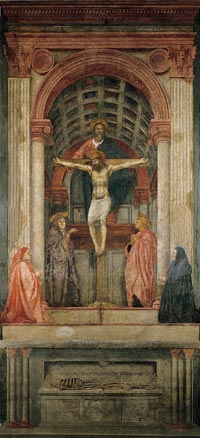
Holy Trinity, in full: "Trinity with the Virgin, Saint John the Evangelist, and Donors" (c. 1427) - Fresco, Santa Maria Novella, Florence
|
